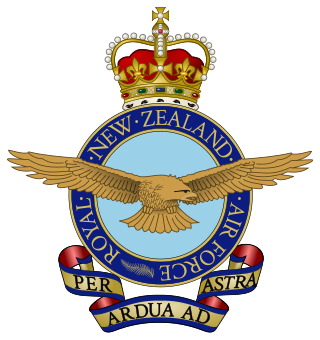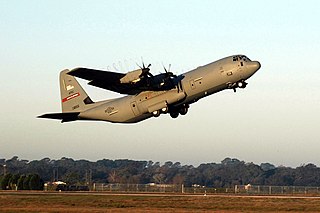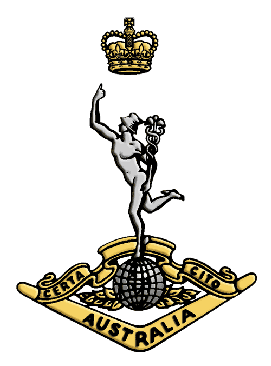
The Royal New Zealand Air Force is the aerial service branch of the New Zealand Defence Force. It was formed initially in 1923 as a branch of the New Zealand Army, being known as the New Zealand Permanent Air Force, becoming an independent air force on 1 April 1937.

The London International Airport is an international airport located in London, Ontario, Canada. It is located 5 nautical miles northeast of the city of London, Ontario and is classified as an airport of entry by Nav Canada. In 2023, the airport was listed as the 17th busiest airport in Canada in terms of aircraft movements with 102,122 flights. The airport posted a record 683,000 travelers in 2019 and 332,447 passengers in 2023. It provides services for cargo airlines and year-round flights with Air Canada Express and WestJet.

The Boeing T-43 is a retired modified Boeing 737-200 that was used by the United States Air Force for training navigators, now known as USAF combat systems officers, from 1973 to 2010. Informally referred to as the Gator and "Flying Classroom", nineteen of these aircraft were delivered to the Air Training Command (ATC) at Mather Air Force Base, California during 1973 and 1974. Two additional aircraft were delivered to the Colorado Air National Guard at Buckley Air National Guard Base and Peterson Air Force Base, Colorado, in direct support of cadet air navigation training at the nearby U.S. Air Force Academy. Two T-43s were later converted to CT-43As in the early 1990s and transferred to Air Mobility Command (AMC) and United States Air Forces in Europe (USAFE), respectively, as executive transports. A third aircraft was also transferred to Air Force Materiel Command (AFMC) for use as the "Rat 55" radar test bed aircraft and was redesignated as an NT-43A. The T-43A was retired by the Air Education and Training Command (AETC) in 2010 after 37 years of service.

The Avro Anson is a British twin-engine, multi-role aircraft built by the aircraft manufacturer Avro. Large numbers of the type served in a variety of roles for the Royal Air Force (RAF), Fleet Air Arm (FAA), Royal Canadian Air Force (RCAF), Royal Australian Air Force and numerous other air forces before, during, and after the Second World War.

Keesler Air Force Base is a United States Air Force base located in Biloxi, a city along the Gulf Coast in Harrison County, Mississippi, United States. The base is named in honor of aviator 2d Lt Samuel Reeves Keesler Jr., a Mississippi native killed in France during the First World War. The base is home of Headquarters, Second Air Force and the 81st Training Wing of the Air Education and Training Command (AETC).
A naval flight officer (NFO) is a commissioned officer in the United States Navy or United States Marine Corps who specializes in airborne weapons and sensor systems. NFOs are not pilots (naval aviators), but they may perform many "co-pilot" or "mission specialist" functions, depending on the type of aircraft. Until 1966, their duties were performed by both commissioned officer and senior enlisted naval aviation observers (NAO).

Sheppard Air Force Base is a United States Air Force (USAF) base located five miles (8.0 km) north of the central business district of Wichita Falls, in Wichita County, Texas, United States. It is the largest training base and most diversified in Air Education and Training Command. The base is named in honor of Texas Senator John Morris Sheppard, a supporter of military preparations before World War II.

Mather Air Force Base was a United States Air Force Base, which was closed in 1993 pursuant to a post-Cold War BRAC decision. It was located 12 miles (19 km) east of Sacramento, on the south side of U.S. Route 50 in Sacramento County, California. Mather Field was one of 32 Air Service training camps established after the United States entry into World War I in April 1917.

No. 2 Squadron RNZAF was a squadron of the Royal New Zealand Air Force (RNZAF). It was formed in 1930 as part of the Territorial Air Force with the main headquarters at Wellington and shadow flights at New Plymouth and Wanganui. Squadron personnel conducted their annual flying at RNZAF Base Wigram. In 1937 the Territorial Squadrons were re-organised and No. 2 Squadron became the Wellington Territorial Squadron.

École nationale de l'aviation civile (ENAC) is one of 205 colleges accredited to award engineering degrees in France. ENAC is designated as a grande école by the Conférence des Grandes écoles (CGE), a non-profit organisation which certifies and monitors grandes écoles. ENAC was founded on 28 August 1949 to provide initial and continuing education in the field of civil aviation. The school is an établissement public à caractère scientifique, culturel et professionnel, and operates under the oversight of the Ministry of Ecological Transition. Affiliated with the University of Toulouse and Aerospace Valley, it is one of the five founders of France AEROTECH.

The Royal Australian Corps of Signals (RASigs) is one of the 'arms' of the Australian Army. It is responsible for installing, maintaining, and operating all types of telecommunications equipment and information systems. The motto of the Signals Corps is Certa Cito and is translated as 'Swift and Sure', signifying the aim of the signal service – that communication be carried out with maximum speed and certainty. Like their British counterparts, the Royal Australian Corps of Signals' flag and hat badge feature Mercury, the winged messenger of the gods, affectionately referred to by members of the corps as "Jimmy".

Naval Air Station Meridian or NAS Meridian is a military airport located 11 miles northeast of Meridian, Mississippi in Lauderdale County and Kemper County, and is one of the Navy's two jet strike pilot training facilities.
The Pilot Training Squadron based at RNZAF Base Ohakea, and trained RNZAF pilots from 1966 until 2015.

A Weapon Systems Officer (WSO), nicknamed "Wizzo", is an air flight officer directly involved in all air operations and weapon systems of a military aircraft.

Wigram Aerodrome is located in the Christchurch suburb of Sockburn, later to be split-suburb of Wigram and now split again as Wigram Skies. It was gifted by Sir Henry Wigram for the Canterbury (NZ) Aviation Company on 20 September 1916 and originally named Sockburn Airport. In 1923 that was then gifted to the Crown as a Royal New Zealand Air Force base. Charles Kingsford Smith made the first Trans-Tasman flight from Sydney to Wigram on 10 September 1928.

Training Squadron TEN (VT-10) is a training squadron of the United States Navy. The squadron is homebased at NAS Pensacola, Florida.

Naval Air Station Kingsville or NAS Kingsville (NASK) is a United States Navy Naval Air Station located approximately 3 miles east of Kingsville, Texas in Kleberg County. NAS Kingsville is under the jurisdiction of Navy Region Southeast and is the headquarters of Training Air Wing Two. The station also operates a nearby satellite airfield, NALF Orange Grove.

Ellington Field Joint Reserve Base is a joint installation shared by various active component and reserve component military units, as well as aircraft flight operations of the National Aeronautics and Space Administration (NASA) under the aegis of the nearby Johnson Space Center. The host wing for the installation is the Texas Air National Guard's 147th Attack Wing. Opened in 1917, Ellington Field was one of thirty-two Air Service training camps established after the United States entry into World War I. It is named for First Lieutenant Eric Ellington, a U.S. Army aviator who was killed in a plane crash in San Diego, California in 1913.
The Naval Air Transport Service or NATS, was a branch of the United States Navy from 1941 to 1948. At its height during World War II, NATS's totaled four wings of 18 squadrons that operated 540 aircraft with 26,000 personnel assigned.
Kenneth William Stewart, was a flying ace of the Royal New Zealand Air Force (RNZAF) during the Second World War. He was officially credited with the destruction of five German aircraft.















